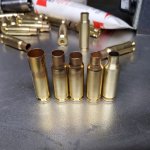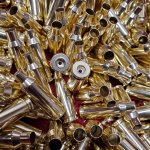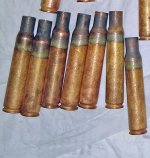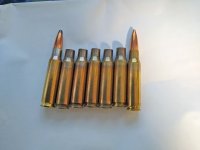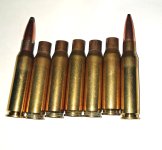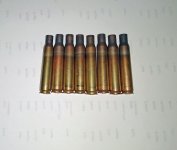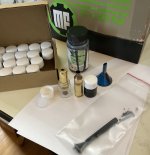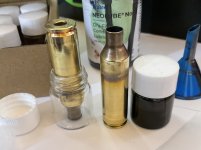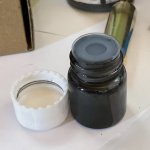More finite control of temp and time.Why is induction more consistent?
Brass color change is not an indication of annealing.
Join the Hide community
Get access to live stream, lessons, the post exchange, and chat with other snipers.
Register
Download Gravity Ballistics
Get help to accurately calculate and scope your sniper rifle using real shooting data.

Install the app
How to install the app on iOS
Follow along with the video below to see how to install our site as a web app on your home screen.
Note: This feature may not be available in some browsers.
You are using an out of date browser. It may not display this or other websites correctly.
You should upgrade or use an alternative browser.
You should upgrade or use an alternative browser.
Annealed brass opinion
- Thread starter Ragin_cajun
- Start date
I suspect he means accurately measured/dispersed energy and not that the case differences are compensated for.Why is induction more consistent?
Brass color change is not an indication of annealing.
If not, then hellifiknow lol
Because the time is consistent. On map gas I can assure you 1/10th of a second you’re not getting consistently because your watching for say the glow. But say 3/10ths vs 1/10th is a difference. Not saying induction is pure consistency. It’s not. But with a torch it’s definitely notWhy is induction more consistent?
Brass color change is not an indication of annealing.
Don't need any high dollar tools to anneal.
It's been done for thousands of years without such equipment.
I prefer to run my red hot blade through a slave, for tempering the sword.
Brass cases being a bit different, I use a heat sink, caliber specific, in a lathe turning at low speed, apply map gas, a few seconds, to the neck shoulder, a slight dull color of red /pink starts on neck, pull with leather glove insert new case with non gloved hand and repeat.
Form lots of cases this way, works for me, and you can definitely tell when heavy case forming takes place. Made 250 6 ARC cases from Starline grendel basic straight wall cases.
Tumble them and ya have no head stamp super bright 250 pcs of 6mm ARC cases, when none are available.
Or 900 .510 Whisper cases when none are available. Or hybrid cases in 308, 6.5 CM,
8.6 Blackout, 358 Win. Etc. Plus 338 RCM made from 6.5 PRC, 35 Rem from 308, to 401 and 351 WSL, and 350 Rem mag. Plus a bunch of others most all required annealing....but no special equipment needed... I already have the lathe, but one could use a drill motor to turn the case.
But you can buy whatever ya want to anneal... or not... they're your cases, but it ain't rocket science.
It's been done for thousands of years without such equipment.
I prefer to run my red hot blade through a slave, for tempering the sword.
Brass cases being a bit different, I use a heat sink, caliber specific, in a lathe turning at low speed, apply map gas, a few seconds, to the neck shoulder, a slight dull color of red /pink starts on neck, pull with leather glove insert new case with non gloved hand and repeat.
Form lots of cases this way, works for me, and you can definitely tell when heavy case forming takes place. Made 250 6 ARC cases from Starline grendel basic straight wall cases.
Tumble them and ya have no head stamp super bright 250 pcs of 6mm ARC cases, when none are available.
Or 900 .510 Whisper cases when none are available. Or hybrid cases in 308, 6.5 CM,
8.6 Blackout, 358 Win. Etc. Plus 338 RCM made from 6.5 PRC, 35 Rem from 308, to 401 and 351 WSL, and 350 Rem mag. Plus a bunch of others most all required annealing....but no special equipment needed... I already have the lathe, but one could use a drill motor to turn the case.
But you can buy whatever ya want to anneal... or not... they're your cases, but it ain't rocket science.
Attachments
First principles:Just tried my first batch of brass with my induction heater and looking for opinions. First off the brass hasn’t been cleaned so that’s why the neck is black but do you guys see anything that looks like I over annealed them? I attempted to stop the instant I saw glowing. I sacrificed a few pieces doing the plier test but can’t tell any difference. Just looking for opinions for safety sake because I really like the gun im shooting them through View attachment 8560134View attachment 8560136
YOU CANNOT GUAGE ANNEALING BY BRASS COLOR
Choose a different metric
Many annealing machines are automated. Every peice of brass spends the same amount if time in the heat.Because the time is consistent. On map gas I can assure you 1/10th of a second you’re not getting consistently because your watching for say the glow. But say 3/10ths vs 1/10th is a difference. Not saying induction is pure consistency. It’s not. But with a torch it’s definitely not
You probably get a little more control over temp, but I doubt many if any machines can heat and reheat their coil as consistently as a flame maintains the same temperature.
They don't make MAPP gas anymore. They make map-pro which burns 10 percent hotter than propane but transfers heat better also.
Why is induction more consistent?
Brass color change is not an indication of annealing.
Correct partially . Color change is an indication of heat signature and to some extent duration at temperature .
Consider the very nature of induction coil partial annealing ; One's case neck shoulder are fully surrounded and near instantly conduct the necessary heat ( duration is always variable and on the operator ) in order to partial anneal a case .
Believe ME ,I'm a BIG fan of induction malleability restoration . It simply isn't as fast multi case cycle wise . In order to do that faster multiple stations are required and runs into unwanted expense .
MY motto don't break what's not broken ,aim for consistence on a budget which one is comfortable with.
For ME Modifying My Annealeeze was more than affordable ,cycling #250-1K cases is very doable , in as short a time as I could practically afford . Some shooters use Bolt guns ( I do to ) and others Semi or Automatics ( I do to ) . The latter being a monster with an appetite ,needs additional feeding and attention .
MY problem too many Rifles ,as I also enjoy building or assembling them ,which ever the case might be .
Last edited:
Color change is caused by chemicals on brass. That's one of the reasons diffrent companies brass turns diffrent colors and why brass with lots of firings that has only been dry tumbled stops changing colors. 
If we have to get to "theoretically" to indicate why one is more consistent. Then the ever so slight diffrence is irrelevant.
If we have to get to "theoretically" to indicate why one is more consistent. Then the ever so slight diffrence is irrelevant.
Some of those funny rainbow colors are just angstroms thick. A regular SEM can "burn" right through without being able to "see" them, and the typical EDX uses too strong of a beam to "see" them. We study these very thin surface layers with a technique called AUGER in case you were curious.
The color layers are often so thin and fragile, that they clean off easily with common case cleaning methods. We can find some factory brass that is absent of the rainbow colors due to their process steps including post heat treat cleaning.
Some companies leave the "rainbow colors" as a matter of showing visual evidence they did their final heat treat, and sometimes it is a contractual agreement between them and folks who buy their brass such that they are required to leave them.
Not all (raw material) cartridge brass is from the same sources, and various specifications can be made that might include various allowable amounts of trace contaminates.
Those various raw material sources are not common to all brands, and can result in big differences in those color layers and their thicknesses.
By and large, those colors are not harmful but the main point I am trying to convey is that they are also not standardized between brands of brass due to the differences in composition, allowable contaminates, and process methods. Try to avoid getting to wrapped up on the colors between different brands.
We only use the micro hardness as a proxy. The properties we are really interested in achieving with the heat treat are correlated to that hardness range, so we use the neck hardness instead because the direct measurements of those much more important values are not practical to measure on thin wall cartridge necks. Carry on.
Merry Christmas, Happy Hanukkah and Happy New Year!
The color layers are often so thin and fragile, that they clean off easily with common case cleaning methods. We can find some factory brass that is absent of the rainbow colors due to their process steps including post heat treat cleaning.
Some companies leave the "rainbow colors" as a matter of showing visual evidence they did their final heat treat, and sometimes it is a contractual agreement between them and folks who buy their brass such that they are required to leave them.
Not all (raw material) cartridge brass is from the same sources, and various specifications can be made that might include various allowable amounts of trace contaminates.
Those various raw material sources are not common to all brands, and can result in big differences in those color layers and their thicknesses.
By and large, those colors are not harmful but the main point I am trying to convey is that they are also not standardized between brands of brass due to the differences in composition, allowable contaminates, and process methods. Try to avoid getting to wrapped up on the colors between different brands.
We only use the micro hardness as a proxy. The properties we are really interested in achieving with the heat treat are correlated to that hardness range, so we use the neck hardness instead because the direct measurements of those much more important values are not practical to measure on thin wall cartridge necks. Carry on.
Merry Christmas, Happy Hanukkah and Happy New Year!
Color change is caused by chemicals on brass. That's one of the reasons diffrent companies brass turns diffrent colors and why brass with lots of firings that has only been dry tumbled stops changing colors.
If we have to get to "theoretically" to indicate why one is more consistent. Then the ever so slight diffrence is irrelevant.
NO Brass ,copper , zinc even steel changes or discolors with Heat applied ,not because of chemicals .
Different companies brass cases are subjected to different treatments ,is why some appear unpolished ( Because they are ) Military especially . Soldiers don't give a rats ass about shiny fodder ,function or polish wins matches or saves lives .
Commercial ammunition manufactures re-polish their brass after partial annealing . Most Euro producers DON'T ,unless exporting to the USA . Then only polish somewhat Lupua ,PPU, Norma three examples .
I've heard nonsense stating every company uses a different % of zinc or copper . Bullshit ,cartridge brass is almost 100% universally accepted as C26000 Cartridge Brass .
IF one is a large enough consumer ,additional alloys can be requested as some of those vary but again mainly due to regional copper and zinc mining facility's or the smelting facility itself . That equates to possible impurities .
Normal ratios appear below ,other trace elements can also be present such a silicon aka Si and aluminum Al .
Forged temperature is : between 732 and 843°C (1350 and 1550°F ).
initial Annealing of UNS C26000 cartridge brass alloys are annealed between 427 and 760°C (800 and 1400 °F ) That makes raw sheets . Now Remember this is PRIOR to punching and DRAWING brass pucks ,which cold hardens Brass . When the cartridge draw is completed ,Partial annealing takes place involving the neck and shoulder ,the two areas most prone too movement . Again by multi station induction heating .
| Cu | 68.5-71.5 |
| Fe | 0.050 |
| Pb | 0.070 |
| Other | 0.15 |
| Zn | 28.5 |
Last edited:
Just an FYI, if you haven't seen this before:NO Brass ,copper , zinc even steel changes or discolors with Heat applied ,not because of chemicals .
Different companies brass cases are subjected to different treatments ,is why some appear unpolished ( Because they are ) Military especially . Soldiers don't give a rats ass about shiny fodder ,function or polish wins matches or saves lives .
Commercial ammunition manufactures re-polish their brass after partial annealing . Most Euro producers DON'T ,unless exporting to the USA . Then only polish somewhat Lupua ,PPU, Norma three examples .
I've heard nonsense stating every company uses a different % of zinc or copper . Bullshit ,cartridge brass is almost 100% universally accepted as C26000 Cartridge Brass .
IF one is a large enough consumer ,additional alloys can be requested as some of those vary but again mainly due to regional copper and zinc mining facility's or the smelting facility itself . That equates to possible impurities .
Normal ratios appear below ,other trace elements can also be present such a silicon aka Si and aluminum Al .
Forged temperature is : between 732 and 843°C (1350 and 1550°F ).
initial Annealing of UNS C26000 cartridge brass alloys are annealed between 427 and 760°C (800 and 1400 °F ) That makes raw sheets . Now Remember this is PRIOR to punching and DRAWING brass pucks ,which cold hardens Brass . When the cartridge draw is completed ,Partial annealing takes place involving the neck and shoulder ,the two areas most prone too movement . Again by multi station induction heating .
Cu 68.5-71.5 Fe 0.050 Pb 0.070 Other 0.15 Zn 28.5
Straightshooter1 is correct.
Some popular domestic and imported brass is also made of C24000 and C28000 or their source continent's equivalent, and there are also some proprietary custom specs as well.
You can always request the alloy to be adjusted in order to change the properties to suite the application, and when the values don't match the usual industry specs you just create your own.
Nothing to get excited about or worry over, all alpha phase brass will behave close enough for this discussion. No worries, carry on.
Merry Christmas and Happy New Year!!!
Some popular domestic and imported brass is also made of C24000 and C28000 or their source continent's equivalent, and there are also some proprietary custom specs as well.
You can always request the alloy to be adjusted in order to change the properties to suite the application, and when the values don't match the usual industry specs you just create your own.
Nothing to get excited about or worry over, all alpha phase brass will behave close enough for this discussion. No worries, carry on.
Merry Christmas and Happy New Year!!!
Yes different grades or specifications of Brass are available ,yet not all of it's small arms cartridge grade brass .Straightshooter1 is correct.
Some popular domestic and imported brass is also made of C24000 and C28000 or their source continent's equivalent, and there are also some proprietary custom specs as well.
You can always request the alloy to be adjusted in order to change the properties to suite the application, and when the values don't match the usual industry specs you just create your own.
Nothing to get excited about or worry over, all alpha phase brass will behave close enough for this discussion. No worries, carry on.
Merry Christmas and Happy New Year!!!
Manufacturer of cartridge brass available in wire, bar, and rod forms. Offered with 0.006 to 0.250 in. thickness and 0.125 to 48 in. width. Grades include 21000, 22000, 22600, 23000, 24000, 26130, 27200, 33500, 35300, and 42200. Anodizing, bending, cladding, deburring, forming, machining, milling, plating, polishing, and cutting are offered as secondary services. Suitable for heat exchangers, caskets, contacts, eyelets, grommets, couplings, vehicles, thermostats, springs, and shipbuilding applications. Serves electronics, telecommunications, aerospace, architectural, automotive, hardware, jewelry, and food industries. Meets ASME or ASTM standards and military specifications.
Don't know what "color change" you're referring to. . .on the necks, below the shoulder, while in the flame, all the above??? Can you be more specific?I did finally see a color change this time around. Not sure why as I did them exactly the same as last time.
View attachment 8695212
^ that made me literally laugh out loud.
I’m going to use that
If you don’t mind me asking, where do you order your neo lube #2 from?
Thx
No joke, just having a hard time finding some that does not have ludicrous shipping/ hazmat or a seller that looks sketchy.Yeah, I’m behind the curve on that one. I don’t even use that so maybe I’m missing the joke. I still smear imperial wax on everything over 30 caliber one at a time.
My ongoing battle with SDs…..
I resemble that remark.I have a brother like you……
But asking online if your brass is annealed. Thats like trimming and asking if it looks short enough.
I resemble that remark.
But asking online if your brass is annealed. Thats like trimming and asking if it looks short enough.
Yep you sure do.
Read my post again, it was a statement of fact, not a question.
Perhaps some quiet meditation, will get those voices in your heads under control.
As for the cases, since they are the same as I have done them many times before, I’m content that they are properly annealed.
Yep you sure do.
Read my post again, it was a statement of fact, not a question.
Perhaps some quiet meditation, will get those voices in your heads under control.
View attachment 8695893
I know you probably already know this, but I am Neill my case and then tumble it for 30 minutes and then resize with about 0.001 inches of neck tension and then I just smear a little bit of imperial wax at the junction of the boattail and the shaft and seat it as smooth as butter. I don’t have the AMP press, but I can tell you that the curve is a narrow.
Rather than dealing with all the molten salt crap I just went for simple... 8 seconds chucked in a drill (with an adapter for the brass) in a propane torch flame, the color comes out looking just like LC brass.
Last edited:
ALL CASES Partial annealed 1275-1350 Deg. F. color under flame just going red and they drop out . Neck and top of shoulders are Fully ductile ,bases of case Never exceeds 220 Deg. F. .
Cases left partial annealed and unpolished . Second set of cases polished near Identical to one Factory Lapua round as were witness mark . Third set of cases partial polish after partial anneal . Fourth set of cases Raw cleaned and partial annealed . I later polished those vary cases along with #47 more . All those are 1942-43 M2 .30 Cal. cases ,which have withstood #50 firings each and ALL reloads were within 1.0 gr. Maximum loading for M1 Garand . Partial annealed after every 4 Th. firing . Never lost a single case or had a torn rim and that's saying plenty out of an 83 year old Battle horse . I did cut two of the original cases ,so as to accurately measure brass case wall for stretch and any evidence of case head separation . ALL GOOD ,I predict another #10 firings minimum and to be on the safe side will fire individually ,so as to prevent Opt Rod fuk up and save MY face just in case
Final word ; IF none of you are seeing any discoloration when partial annealing your brass , YOU'RE DOING IT WRONG . FACT Brass discolors when heated to ductility stage and that's what it's about !.
Cases left partial annealed and unpolished . Second set of cases polished near Identical to one Factory Lapua round as were witness mark . Third set of cases partial polish after partial anneal . Fourth set of cases Raw cleaned and partial annealed . I later polished those vary cases along with #47 more . All those are 1942-43 M2 .30 Cal. cases ,which have withstood #50 firings each and ALL reloads were within 1.0 gr. Maximum loading for M1 Garand . Partial annealed after every 4 Th. firing . Never lost a single case or had a torn rim and that's saying plenty out of an 83 year old Battle horse . I did cut two of the original cases ,so as to accurately measure brass case wall for stretch and any evidence of case head separation . ALL GOOD ,I predict another #10 firings minimum and to be on the safe side will fire individually ,so as to prevent Opt Rod fuk up and save MY face just in case
Final word ; IF none of you are seeing any discoloration when partial annealing your brass , YOU'RE DOING IT WRONG . FACT Brass discolors when heated to ductility stage and that's what it's about !.
Attachments
Final word ; IF none of you are seeing any discoloration when partial annealing your brass , YOU'RE DOING IT WRONG . FACT Brass discolors when heated to ductility stage and that's what it's about !
I'll be sure to let AMP know
I know you probably already know this, but I am Neill my case and then tumble it for 30 minutes and then resize with about 0.001 inches of neck tension and then I just smear a little bit of imperial wax at the junction of the boattail and the shaft and seat it as smooth as butter. I don’t have the AMP press, but I can tell you that the curve is a narrow.
I de-cap, tumbled for 4 hrs in walnut. Annealed, then size, mandrel to .002 neck tension and tumble another hour to get the lube off. Then like you, I lube the bullet.
There’s an emerging trend where a bunch of guys that are saying that you should kneel first and then tumble for only a short time and that it removes oxidation in the neck caused by the kneeling and makes your seating force more consistent due to less friction
I used to do it exactly in the order that you described, but I recently switched and I do think that my seating force is both less force and more consistent
I used to do it exactly in the order that you described, but I recently switched and I do think that my seating force is both less force and more consistent
I'll be sure to let AMP know
Lapua Brass Case New ; So perhaps Lapua needs to speak with Amp .
A round about way of explaining it but Factual none the less is ; Luckygunner video . Fyi : EVERY single Rifle bottleneck cartridge or case regardless of manufacturer ,is partial annealed . Some manufacturers simply polish their cases longer after annealing to minimize it's discoloration process . Look close enough and it's ALWAYS THERE . NO Difference ,Induction heating or flame = 1275-1350 Deg. F and discoloration .
https://www.luckygunner.com/lounge/annealing/
You're right about what manufacturers do to the cases, either the polish away the evidence of annealing or purposefully leaving some color as evidence the the annealing (like Lapua does).Lapua Brass Case New ; So perhaps Lapua needs to speak with Amp .
A round about way of explaining it but Factual none the less is ; Luckygunner video . Fyi : EVERY single Rifle bottleneck cartridge or case regardless of manufacturer ,is partial annealed . Some manufacturers simply polish their cases longer after annealing to minimize it's discoloration process . Look close enough and it's ALWAYS THERE . NO Difference ,Induction heating or flame = 1275-1350 Deg. F and discoloration .
https://www.luckygunner.com/lounge/annealing/
View attachment 8697108
It's not hard to get rid of the "color change" after annealing. Like when I annealed some 277 Fury cases in prep for necking them up to .308's. Here's a pic of 10 cases that weren't cleaned after annealing that I loaded up to fire form and the other pick of cases that looked the same until after annealing that I wet tumbled for 25 minutes
Whether or not the color change 'shows' - and how much - has a fair bit to do with the surface condition of the brass at the time of annealing. I - and many others - have taken cases from the same batch, ran them through the same annealing process, some showed a color change, some didn't. One could argue that the color change was still there, just faint. Maybe. Don't care.
I'll take my AMP code over some visual 'looks good' setting every day of the week. Way less variability.
I'll take my AMP code over some visual 'looks good' setting every day of the week. Way less variability.
While you're right that any color change just has "to do with the surface condition of the brass" (like, residual cleaning solutions), the patina (color change) can be useful in getting some good idea where the heat is acting on the brass. Like, if the patina goes halfway down the case, too much heat is going too farWhether or not the color change 'shows' - and how much - has a fair bit to do with the surface condition of the brass at the time of annealing. I - and many others - have taken cases from the same batch, ran them through the same annealing process, some showed a color change, some didn't. One could argue that the color change was still there, just faint. Maybe. Don't care.
I'll take my AMP code over some visual 'looks good' setting every day of the week. Way less variability.
Running case necks at the same temperature for the same amount of time gets them pretty consistent, even with flame annealing. The AMP's coding and electronics makes that all much more precise and very good deal for those who don't care to understand the physics of the annealing process and want the easy button.
I care about all of that and still use an AMP. Now what?The AMP's coding and electronics makes that all much more precise and very good deal for those who don't care to understand the physics of the annealing process and want the easy button.
I care about all of that and still use an AMP. Now what?
Can you remind us what you did and what the original problem was
No problem, just ironing out my process among the vast maze of opinions on the subject matter. I had not seen a color change until this run, which in hindsight I am not sure is anything more than a mark from the hot edge of the roller on the ugly annealer.
Oh and this was the smoothest push through the Redding FL sizing bushing die. From day one this ADG 6.5 PRC has been the most difficult of any brass I have sized before. I have to use Hornady Unique Case Lube as the Alpha and Imperial wax lubes are much more difficult.
You're right about what manufacturers do to the cases, either the polish away the evidence of annealing or purposefully leaving some color as evidence the the annealing (like Lapua does).
It's not hard to get rid of the "color change" after annealing. Like when I annealed some 277 Fury cases in prep for necking them up to .308's. Here's a pic of 10 cases that weren't cleaned after annealing that I loaded up to fire form and the other pick of cases that looked the same until after annealing that I wet tumbled for 25 minutes:
View attachment 8697212 View attachment 8697213
You're right about what manufacturers do to the cases, either the polish away the evidence of annealing or purposefully leaving some color as evidence the the annealing (like Lapua does).
It's not hard to get rid of the "color change" after annealing. Like when I annealed some 277 Fury cases in prep for necking them up to .308's. Here's a pic of 10 cases that weren't cleaned after annealing that I loaded up to fire form and the other pick of cases that looked the same until after annealing that I wet tumbled for 25 minutes:
View attachment 8697212 View attachment 8697213
If one looks close enough to where partial annealing has taken place ( regardless New ,Used Cases or ammunition ; Neck Shoulder ) they'll see a " Finer Grain Detail " or smoother outer brass surface appearance ,than the remaining portion of case or ammunition .
A very close Personal as well as Professional Friend ran Norma for better than 30 years . Early 2K's I accepted an invitation to not only tour Norma & Bofors Powder but also Lapua facilities in Finland . Interesting to say the least and also somewhat informative . NO secrets divulged I'm afraid but complete visual access to all portions of operations . Ammunition assembly as well as powder manufacturing were restrictive access ,as would be expected in a production facility .
Saab aka Celisius Group owned Bofor and rumored at the time I visited was looking to sell Bofor .
If you don’t mind me asking, where do you order your neo lube #2 from?
Thx
Yeah, I’m behind the curve on that one. I don’t even use that so maybe I’m missing the joke. I still smear imperial wax on everything over 30 caliber one at a time.
For anyone looking for Neo Lube #2 I finally got some here: https://ebay.us/m/BCiiKE
Same seller sells on Amazon and Walmart marketplace. Was shipped promptly and sealed well will blue tape. I think the factory does that.
Took a whiff and it smells of denatured alcohol….ugh Nasty stuff. I ordered a tiny vial for “dip work”. Hopefully that will keep the smell down. Since I had to buy a few vials with lids I will experiment with drilling a hole the diameter of my brass and perhaps a wipe for the brass exterior.
If I start posting incoherently, you’ll know what happened.
Ever try Tungsten Di-sulfide aka WS2 powder ?. Just curious as I've used both HBN and WS2For anyone looking for Neo Lube #2 I finally got some here: https://ebay.us/m/BCiiKE
Same seller sells on Amazon and Walmart marketplace. Was shipped promptly and sealed well will blue tape. I think the factory does that.
Took a whiff and it smells of denatured alcohol….ugh Nasty stuff. I ordered a tiny vial for “dip work”. Hopefully that will keep the smell down. Since I had to buy a few vials with lids I will experiment with drilling a hole the diameter of my brass and perhaps a wipe for the brass exterior.
If I start posting incoherently, you’ll know what happened.Although come to think of it, that won’t be much different than my postings now. Except my brain will be dribbling out my nose.
https://www.ebay.com/itm/124111039917?_trksid=p2332490.c101224.m-1
- ULTRA FINE GRADE 0.5 micrometer (micron, µm) average particle size. The finest grade for lubrication
- Can be coated on a surface by buffing, spraying or tumbling.
- Compatible with ALL metals, ALL plastics and elastomers, water, solvents, fuels, oils, paints, plastic resins.
- Lowest coefficient of friction of any of the commonly used dry lubricants including molybdenum disulfide, graphite and hexagonal boron nitride.
- Temperature use range superior to molybdenum disulfide and to other dry lubricants: from -450ºF (-270ºC) to 1200ºF (650ºC) in air.
Ever try Tungsten Di-sulfide aka WS2 powder ?. Just curious as I've used both HBN and WS2
https://www.ebay.com/itm/124111039917?_trksid=p2332490.c101224.m-1
- ULTRA FINE GRADE 0.5 micrometer (micron, µm) average particle size. The finest grade for lubrication
- Can be coated on a surface by buffing, spraying or tumbling.
- Compatible with ALL metals, ALL plastics and elastomers, water, solvents, fuels, oils, paints, plastic resins.
- Lowest coefficient of friction of any of the commonly used dry lubricants including molybdenum disulfide, graphite and hexagonal boron nitride.
- Temperature use range superior to molybdenum disulfide and to other dry lubricants: from -450ºF (-270ºC) to 1200ºF (650ºC) in air.
Thanks!
I was hoping this liquid Neo Lube #2 wouldn't raise hell with my allergies like graphite powder does……I found @Rocketmandb findings using neo lube #2 compelling as well.
Have you had a chance to test it yet?Thanks!
I was hoping this liquid Neo Lube #2 wouldn't raise hell with my allergies like graphite powder does……I found @Rocketmandb findings using neo lube #2 compelling as well.
As an aside, I tested powdered moly, powdered graphite, HBN, and neolube. With the exception of HBN, which I found to yield the most inconsistent seating forces (by a long shot), the rest were pretty close, but neolube won out. What I saw was that the spread in seating force was similar, but that neolube's spread was due to one or two "flyers" with the rest grouped very tightly.
I'll see if I can find some of the old plots. Honestly, though, the difference between any of them (with the exception of HBN) is so small that any would work. I find neolube, being liquid, quicker and cleaner to apply. Some people "paint" the inside of the necks - I dip the cases.
These are all from my 6 BRA:
Graphite:

Ultrasonic Cleaned - No Lube:

Tumbled Clean - No Lube:

Moly on once-fired - note that the overall friction is higher - I think due to being only once-fired:

50/50 Moly/Graphite Blend:

Moly for Mandrel then NeoLube:

Graphite:
Ultrasonic Cleaned - No Lube:
Tumbled Clean - No Lube:
Moly on once-fired - note that the overall friction is higher - I think due to being only once-fired:
50/50 Moly/Graphite Blend:
Moly for Mandrel then NeoLube:
When you say "Tumbled Clean", what kind of tumbling does that refer to in this particular case? Dry (vibrator) Tumble and with what media??? Wet tumble, with or without SS pins??? I ask because all these variations produce very different results.These are all from my 6 BRA:
Graphite:
View attachment 8707486
Ultrasonic Cleaned - No Lube:
View attachment 8707481
Tumbled Clean - No Lube:
View attachment 8707484
Moly on once-fired - note that the overall friction is higher - I think due to being only once-fired:
View attachment 8707485
50/50 Moly/Graphite Blend:
View attachment 8707482
Moly for Mandrel then NeoLube:
View attachment 8707483
Have you had a chance to test it yet?
As an aside, I tested powdered moly, powdered graphite, HBN, and neolube. With the exception of HBN, which I found to yield the most inconsistent seating forces (by a long shot), the rest were pretty close, but neolube won out. What I saw was that the spread in seating force was similar, but that neolube's spread was due to one or two "flyers" with the rest grouped very tightly.
I'll see if I can find some of the old plots. Honestly, though, the difference between any of them (with the exception of HBN) is so small that any would work. I find neolube, being liquid, quicker and cleaner to apply. Some people "paint" the inside of the necks - I dip the cases.
I just did “dipped” about 25 cases. I ordered some small glass vials to separate my working supply from the main container which is pretty much my SOP with any such material. I guessed on the size and I gambled perfectly. The 6.5 PRC slides right in with little room to spare. Obviously my 6.5 cm will fit nicely too. I bought some little funnels but I decided to switch to eye droppers for transfer. Less mess and loss. I fill the vial just high enough to do the necks as I dip and to allow for the level to lower as I go.
I was pleasantly surprised that I hardly noticed the smell at all. Having said that, I did notice that my heart rate was up when I was done doing 20 cases. I’ll try for more ventilation in the future.
I also did this job before priming where with other lubes I do it after. This is imperative.
I found out the hard way to wear gloves. It took pumice hand cleaner and scrubbing to get it off.
If you are not using the brush on the cap, it’s a nuisance. A quick twist with pliers and it comes right off. It can be reinstalled should it be needed in the future.
So far I like it! Fingers crossed
Attachments
When you say "Tumbled Clean", what kind of tumbling does that refer to in this particular case? Dry (vibrator) Tumble and with what media??? Wet tumble, with or without SS pins??? I ask because all these variations produce very different results.
Sorry - should have specified. Those were dry tumbled with corn cob.
Similar threads
- Replies
- 8
- Views
- 520
